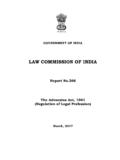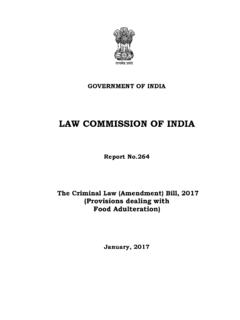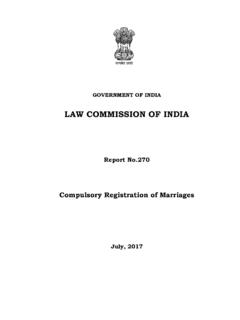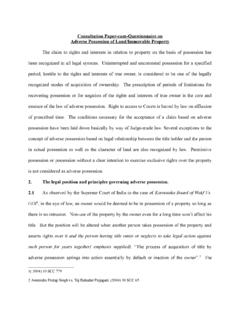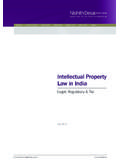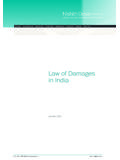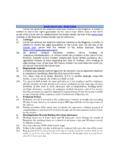Transcription of GOVERNMENT OF INDIA LAW COMMISSION OF …
1 GOVERNMENT OF INDIA . LAW. COMMISSION . OF. INDIA . section 498a IPC. Report AUGUST 2012. ii section 498a IPC. INDEX. Sl. No. Title Page Nos 1. Introduction 1-3. 2. Judicial decisions 3-8. 3. Some data regarding Prosecutions u/s 498-A 9-10. 4. Arguments: Pro & Contra 10-11. 5. The Triple Problem 12-13. 6. View of National COMMISSION for Women 13. 7. The Approach and views of the COMMISSION broadly 14-16. 8. Compounding the Offence 16-19. 9. Domestic Violence Act 19-21. 10. Responses an overview 21-23. 11. Diagnosis of the problem and reasonable solution 23-25. 12. Power of Arrest a balanced approach 25-27. 13. Analysis of the provisions relating to arrest and the duty of 27-33. police 14. Certain guidelines / prescriptions to mitigate misuse 33-35. 15. Home Ministry's advisory and further action to be taken 35-37.
2 16. Amendment of section 41 by the addition of sub- 37. section (3). 17. S, 358 of raising the compensation limit 37-38. 17-A Punishment for misuse no specific provision necessary. 38. 18. State's obligation to take care of estranged women in 38-40. distress 19. Summary of Recommendations 40-43. Annexure I 44-50. Annexure II 51-57. Annexure III 58-73. Annexure III-A 74. Annexure III-B 75-81. Annexure III-C 82-85. iii section 498a IPC. 1. Introduction Keeping in view the representations received from various quarters and observations made by the Supreme Court and the High Courts, the Home Secretary, GOVERNMENT of INDIA through his letter dated 1st September, 2009 requested the Law COMMISSION of INDIA to consider suggesting amendment, if any to of Indian Penal Code or other measures to check the alleged misuse of the said provision.
3 Thereafter, in the case of Preeti Gupta vs. State of Jharkhand, (2010) the Supreme Court observed that serious re- look of the entire provision is warranted by the Legislature. It is a matter of common knowledge that exaggerated versions of the incident are reflected in a large number of complaints. The tendency of over-implication is also reflected in a very large number of cases . Copy of the Judgment has been directed to be sent to the Law COMMISSION and Union Law Secretary for taking appropriate steps. The Law COMMISSION of INDIA after intense deliberations released a Consultation Paper-cum-Questionnaire which is attached to this report as Annexure-I. was introduced in the year 1983 to protect married women from being subjected to cruelty by the husband or his relatives. A punishment extending to 3 years and fine has been prescribed.
4 The expression cruelty' has been defined in wide terms so as to include inflicting physical or mental harm to the body or health of the woman and indulging in acts of harassment with a view to coerce her or her relations to meet any unlawful demand for any 1. property or valuable security. Harassment for dowry falls within the sweep of latter limb of the section . Creating a situation driving the woman to commit suicide is also one of the ingredients of cruelty'. The offence under is cognizable, non-compoundable and non-bailable. The section is extracted below: 498a . Husband or relative of husband of a woman subjecting her to cruelty Whoever, being the husband or the relative of the husband of a woman, subjects such woman to cruelty shall be punishable with imprisonment for a term which may extend to three years and shall also be liable to fine.
5 The purpose of this section , cruelty means- (a) any willful conduct which is of such a nature as is likely to drive the woman to commit suicide or to cause grave injury or danger to life, limb or health (whether mental or physical) of woman; or (b) harassment of the woman where such harassment is with a view to coercing her or any person related to her to meet any unlawful demand for any property or valuable security or is on account of failure by her or any person related to her to meet such demand.. Several enactments and provisions have been brought on the statute book during the last two or three decades to address the concerns of liberty, dignity and equal respect for women founded on the community perception that women suffer violence or deprived of their constitutional rights owing to several social and cultural factors.
6 Meaningful debates and persuasions have led to these enactments. The insertion of section 498a IPC is one such move and it penalizes offensive conduct of the husband and his relatives towards the married woman. The provision together with allied provisions in Cr. are so designed as to impart an element of deterrence. In course of time, a spate of 2. reports of misuse of the section by means of false / exaggerated allegations and implication of several relatives of the husband have been pouring in. Though there are widespread complaints and even the judiciary has taken cognizance of large scale misuse, there is no reliable data based on empirical study as regards the extent of the alleged misuse. There are different versions about it and the percentage of misuse given by them is based on their experience or ipse dixit, rather than ground level study.
7 2. Judicial decisions In the case of Preeti Gupta Vs. State of Jharkhand1 (supra) decided in 2010, the Supreme Court observed that a serious relook of the provision is warranted by the Legislature. The Court said: It is a matter of common knowledge that exaggerated versions of the incidents are reflected in a large number of complaints . The Court took note of the common tendency to implicate husband and all his immediate relations. The Supreme Court directed the Registry to send a copy of judgment to the Law COMMISSION and Union Law Secretary so that appropriate steps may be taken in the larger interests of society. In an earlier case also - Sushil Kumar Sharma Vs. UOI2. (2005), the Supreme Court lamented that in many instances, complaints under were being filed with an oblique motive to wreck personal vendetta and observed.
8 It may therefore become necessary for the Legislature to find out ways how the makers of frivolous complaints or allegations can be 1. AIR 2010 SC 3363. 2. 2005 6 SCC 281. 3. appropriately dealt with . It was also observed that by misuse of the provision, a new legal terrorism can be unleashed . Various High Courts in the country have also noted that in several instances, omnibus allegations are made against the husband and his relations and the complaints are filed without proper justification. The need to exercise caution in the case of arrest of the husband and his relatives has been stressed while observing that by such a step, the possibility of reconciliation becomes remote and problematic. In some of the cases, directions were given by the High Courts for regulating the power of arrest and for taking necessary steps to initiate conciliatory effort at the earliest point of time.
9 Reference may be made in this context to the decision of Delhi High Court in Chandrabhan Vs. State (order dated in Bail application ) and of the Madras High Court in the case of Tr. Ramaiah Vs. State (order dated and in MP of 2008 in Crl. of 2008). In the former case, it was observed that there is no iota of doubt that most of the complaints are filed in the heat of the moment over trifling fights and ego clashes. It is also a matter of common knowledge that in their tussle and ongoing hostility, the hapless children are the worst victims . The following directions were given to the police authorities: i) FIR should not be registered in a routine manner. ii) Endeavour of the police should be to scrutinize complaints carefully and then register FIR. iii) No case under section 498-A/406 IPC should be registered without the prior approval of DCP/Addl.
10 DCP. iv) Before the registration of FIR, all possible efforts should be made for reconciliation and in case it is found that there is no possibility of 4. settlement, then, necessary steps should, in the first instance, be taken to ensure return of sthridhan and dowry articles to the complainant. v) Arrest of main accused be made only after thorough investigation has been conducted and with the prior approval of the ACP/DCP. vi) In the case of collateral accused such as in-laws, prior approval of DCP should be there on the file.. The other directions given were :- The Delhi Legal Services Authority, National COMMISSION for Women, NGOs and social workers working for upliftment of women should set up a desk in Crime Against Women Cell to provide them with conciliation services, so that before the State machinery is set in motion, the matter is amicably settled at that very stage.

